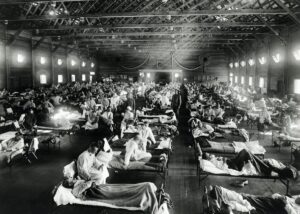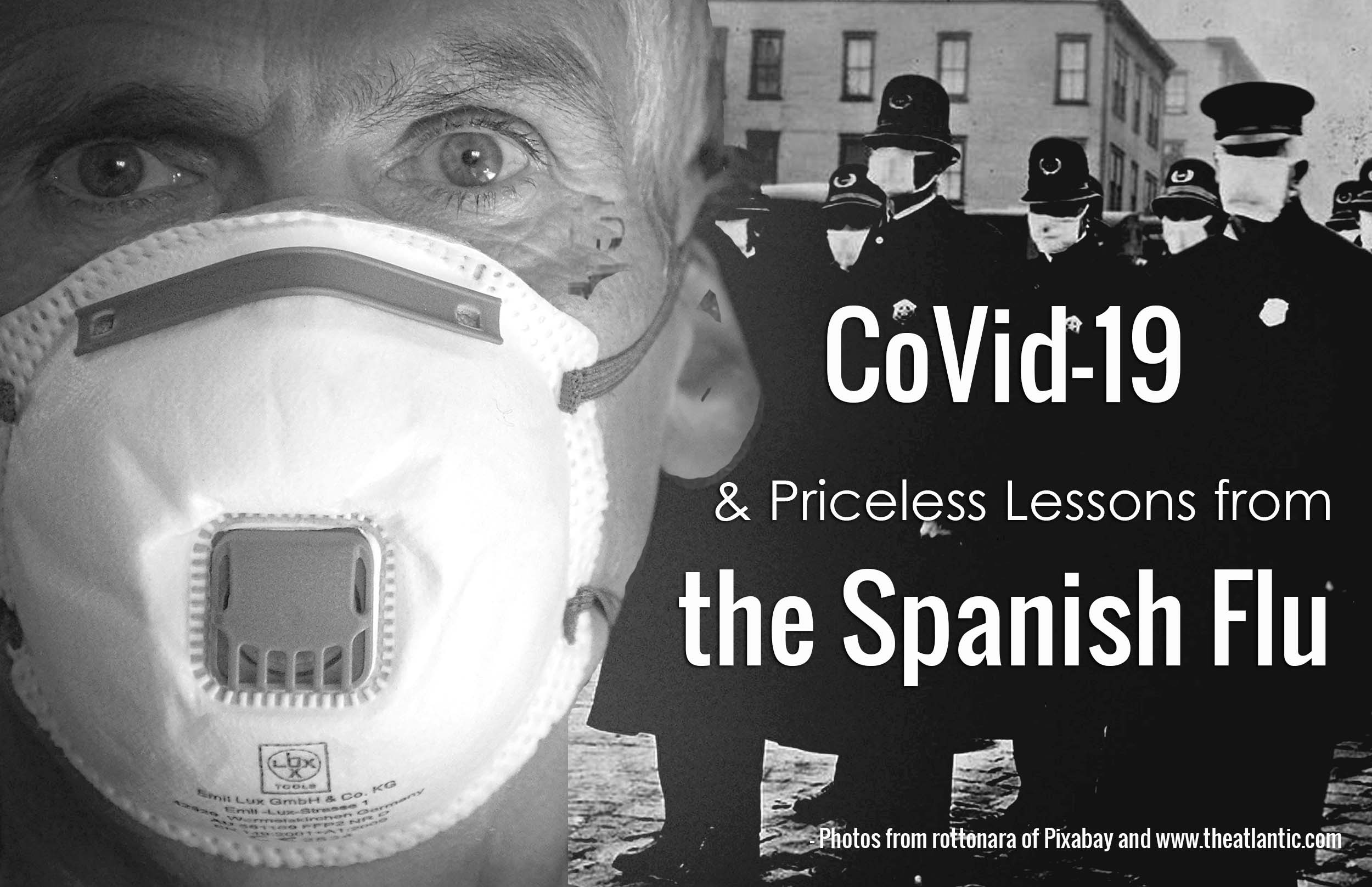I keep hearing about the Spanish Flu of 1918 and how it is compared to the present pandemic of 2020, the Covid-19. So I set about to educate myself. In the process, I found lessons from the Spanish flu which can beat CoVid-19. I hope that with this post, you’d be informed as well.
But first, a brief background:
CoVid-19 and the Spanish Flu Compared

The Spanish Flu: The Virus which killed more people than World War I
Contrary to its name, the Spanish flu did not originate in Spain. It was named as such because Spain, being neutral during the first World War, reported on this freely and widely, as opposed to other nations which suppressed the news.
Until now, there are various speculations, even after careful studies, of where it came from.
Some suggest that it came from France, some from Britain. Another theory was it originated in New York due to evidence of a pre-pandemic wave of the virus in that city. Canadian historian Mark Humphries, however, in a 2014 study claims that it came from the shipment of Chinese laborers across Canada in sealed train cars, pinpointing China as its point of origin.
If the latter is true, the connection between the Spanish flu and CoVid-19 cannot be underrated. CoVid-19 broke out from Wuhan, China.
The Spanish flu of 1918 infected as much as 40 percent of the global population–estimated at 1.8 billion at the time– over the next 18 months. The number of deaths caused by this virus were estimated as 20 to 50 million, and even up to 100 million–more than the roughly 17 million people killed during the War. Famous persons afflicted by this flu and survived were American President Woodrow Wilson and Walt Disney, Mickey Mouse’s creator.
CoVid-19 Pandemic
Did you know that in 2018, in the centennial anniversary of the Spanish flu, some experts predicted that it was only a matter of time until a similar strain re-emerges? They stipulated that the influenza or flu virus never left, but instead evolves into different strains over the years. Following this thinking, a strain as deadly and contagious as the Spanish flu wasn’t far off.
Fast forward to present, and we have CoVid-19 — barely two years after these words of doom were spoken.
As of this writing (April 24, 2020 – 6:35 a.m. Philippine time), there are 2,712,425 CoVid cases around the world, affecting 210 countries and territories. The United States of America leads the number of cases with a total of 878,006. The Philippines has 6,981 with Quezon City, my place of residence, leading with 1,085 cases.
Point of origin of CoVid-19 was in Wuhan, China last December 2019.
Similarities of CoVid-19 and the Spanish Flu
1. Both caused by novel viruses originating from animals transferred to man
Novel viruses are new viruses not seen before. The 1918 Spanish flu was caused by an H1N1 virus from birds. COVID-19 is caused by a coronavirus called SARS-CoV-2 which are common in many different species of animals, including bats. From bats, it was transmitted with a secondary host, said to be a pangolin, prized for its meat and used for traditional medicine in China. It was discovered that many of the patients in Wuhan, China had some link to a large seafood and live animal market, suggesting animal-to-person spread, which later passed through person-to-person.
2. Rapid rate of transmission
During WW1, soldiers and laborers were being transported from one place to another. This is the major factor in the spread of the virus. In the case of CoVid-19, air travel was the main culprit. From there, it was easy for the corona virus to spread in many countries.
Both viruses are also transmitted through respiratory droplets and contact with contaminated surfaces. Whether
3. Public and Government response
Schools and businesses closed, wearing of face masks, travel ban, restricted movements and pronouncements of preventative measures are common in the two pandemics, the only difference being that at present, social media plays a big role in disseminating information.
It is important to note the negative responses as well: indecisiveness of political leaders, late responses, playing down the virus, ignoring lockdowns and proper hygiene, blaming one another. In 1918, for instance, some government leaders told people to ignore quarantine, almost the same as the “offer” of a city mayor for her city to be a control group to see how many people die without social distancing.
Then and now, people are willing to risk their lives just to get back to their normal routine, or go back to work or business without considering the pandemic’s deadly effect.
Las Vegas Mayor offers city as "control group", "we offer to be a control group" to see how many people die without social distancing. pic.twitter.com/NESE2hActE
— Josh Marshall (@joshtpm) April 22, 2020
4. Overcrowded Hospitals, Overworked and Underpaid Health Care Workers and Frontliners
History records that in 1918, nurses, doctors and other medical personnel were in short supply, like the scenario we see today in our television screens. Today, however, we are more painfully aware of the lack of Personal Protective Equipments (PPE), the occasional oppression toward our frontliners, and their infection and death caused by CoVid-19 through media blasts and social media engagement.
5. False Claims and Quick Bucks
Both pandemics brought out people who profited from the public’s panic by selling snake oil purported to cure or protect them from the flu, or by overpricing alcohol, PPE’s and other essential items. False claims abound, too — like eating bananas or going into a sauna to kill the virus.
6. The Absence of Vaccine
Lastly, a vaccine is yet to be created against the Spanish flu and CoVid-19.
Differences between CoVid-19 and the Spanish Flu
While there are similarities between the two pandemics, there are also vast differences.
The Spanish flu remains the most deadly and worst pandemic of all time, with incubation period (the time from exposure to development of signs and symptoms) of just 1-2 days; CoVid-19 takes up to 14 days.
While both the Spanish flu and COVID-19 are infectious respiratory illnesses, sharing some symptoms like fever, coughing, and body aches, Spanish flu also caused nausea and diarrhea, and the lungs in patients with the Spanish flu were filled with a frothy and blood substance, causing suffocation with patients turning blue. CoVid-19 patients typically suffer from dry cough, shortness of breath or difficulty of breathing.
The most affected groups in the 1918 pandemic were healthy adults between the ages of 20 to 40, children less than 5 years old, and people who were 65 years and older. In the case of CoVid-19, adults over the age of 65 with underlying health conditions are the most affected while the younger generation are the most likely to survive.
The most significant difference of all is the privilege of our times. Compared to 1918, we now have better hospital facilities, more skillful and efficient doctors, nurses and health workers, and considerable advances in medical technology. Public awareness is also rapidly and widely spread through digital means.
These privileges may well be our edge in beating CoVid-19. But they could also be worthless if we do not apply the lessons from the Spanish flu experience.
Takeaways from Spanish Flu Experience
The vast majority of deaths caused by the Spanish flu took place in September to October, 1918, popularly known as the “second wave.” Historians attributed this to the lack of quarantine, citing the unwillingness of public officials to implement strict civilian lockdown to prevent the crippling of wartime efforts. It also didn’t help when thousands of nurses were deployed to military camps and front lines, creating a huge shortage for the public.
When World War I ended in November 1918, crowds in Boston gathered to celebrate the armistice. Immediately after, cases of flu resurged. A similar scenario ensued when Bostonians gathered to celebrate Christmas, resulting in deaths.
The cities of Los Angeles and San Francisco had their own tales of tragedy when they prematurely celebrated and lifted restrictions before the pandemic’s end.
Fast forward to today: At this moment, there is news that a resurgence of CoVid-19 is occurring in Northeast China. There are instances when relaxing travel ban policies caused countries which had initially flattened the curve to do them all over again because of re-emerging CoVid-19 cases.
Will we not learn from the lessons of the past? Based on history, there is a need to implement stringent, collective and simultaneous methods to beat CoVid-19. Governments must take decisive actions with specific guidelines for implementation and exhaustive efforts in preventing new infections, testing and tracing, and abating the physical and economic suffering of their constituents.
It has been proven that prematurely lifting quarantines and relaxing lockdowns and travel bans will cause the disease to resurge and spread more widely, forcing repeated and longer periods of restrictions which can be more harmful for the economy in the long run. On the contrary, those that adopted non-pharmaceutical interventions (staying home, physical distancing, proper hygiene, etc.) had fewer deaths and faster economic recovery.
There is also the probability of a second or even third wave, like the Spanish flu experience. While coronaviruses tend to be genetically fairly stable than the Spanish flu virus, we must remember that CoVid-19 is a novel virus. Whether it will disappear or reappear in waves or act in an entirely unexpected way is still a question.
Lockdowns, physical distancing, and staying home are not the only ways we can minimise new CoVid-19 infections. Equally important is to perform widescale testing and contact tracing to find asymptomatic carriers to be isolated for 14 days, thus preventing further spread of the pandemic. The search is on for a potential vaccine, and while this is underway, it is still best to restrict movements.
The Spanish flu lasted for two years. Must we assume that CoVid-19 would last that long? No one really knows. One thing’s for sure: CoVid-19 is still here, and the curve is not even moderately flattened.
Better safe than sorry.
Additional references:
- https://www.cdc.gov/coronavirus/2019-nCoV/index.html
- https://www.cidrap.umn.edu/news-perspective/2020/04/great-influenza-author-talks-covid-19-1918-flu
- https://www.washingtonpost.com/news/powerpost/paloma/the-health-202/2020/04/20/the-health-202-twelve-lessons-the-1918-flu-epidemic-can-teach-us-about-the-novel-coronavirus/5e9c413388e0fa101a765def/
- https://warontherocks.com/2020/04/covid-19-and-the-spanish-flu-pandemic-of-1918-19/
Want to see my Books? Browse them Here.



This is enlightening, at the same time scary and sad. I pray that we get over this very soon. A lot of people are losing their jobs, families are hungry, and the president is even threatening to declare martial law. Let’s help heal each other by staying at home, and staying healthy. Excellent post.